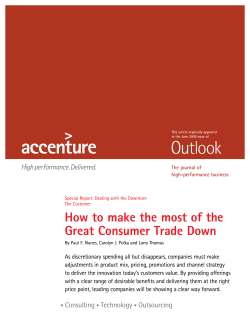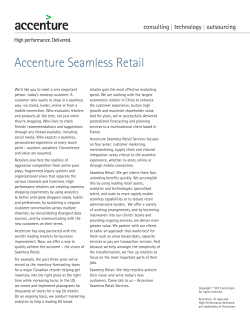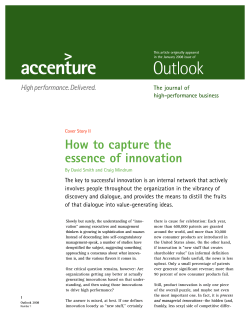
How to transform the business model From analog to digital
This article originally appeared in the 2012, No. 2, issue of The journal of high-performance business Strategy From analog to digital How to transform the business model By John Jackson, Oliver Grange and Kevin Millan M ost consumer-facing businesses are now using digital tools to get closer to customers. Far fewer are close to completing the challenging but essential journey to a holistic, integrated model, with shared assets and platforms, and an overarching digital approach. a ccenture.com/outlook In a world of growing digital empowerment, consumer-facing businesses have had to become quick studies. Frontline managers see that digital technologies offer the promise not just of more cost-effective ways of doing things but of more meaningful and valuable relationships with customers. Richer communication channels and a wealth of customer data enable a new connectedness, and there’s a powerful impetus to make the connections before a competitor—perhaps an entirely new one—does so. Ironically, perhaps, these initiatives in digital marketing, social media and the like are often the work of pioneering units at organizations still largely anchored in the analog age. As it happens, these digital efforts are ramping up just as another major trend is peaking. For most of these same companies, the focus over the last decade has been on globalizing the business model and its constituent processes and services, from finance to HR to supply chain management. Migrating from local to regional to global models, they’ve reaped big benefits in operational efficiency and scale. Now the stage is set for a major convergence, whereby the globalized business model meets a digitized, increasingly customer-connected value chain. Instead of treating new digital efforts as isolated projects, companies have begun working toward a holistic, integrated global digital business model, with shared digital assets and platforms and an overarching digital approach that clearly supports the business strategy. For those most adept at implementing it, the model will deliver significant competitive advantage in the form of scale, speed to market, agility and closeness to the customer. 2 Outlook 2012 Number 2 Imbalance of power Two main drivers give this transformation urgency. Call the first a digital arms race: More and more companies are striving to put the large amounts of customer data they now possess to strategic use. Automakers, for example, through the use of the GPS devices installed in the cars they sell, have been able to collect and monetize a wealth of data on customer driving habits. Even more significant is the rapid shift of the technological balance of power toward the consumer. At the turn of the millennium, companies spent twice as much on IT hardware per employee as consumers spent. By 2008, the two sides had reached parity. The explosion of social media has underscored this shift. There are now more than 1 billion social media users worldwide, including 256 million in China alone. And that has serious implications for business. A recent study by market research company AYTM showed that 58 percent of Facebook users have “liked” a brand, and that 39 percent of Twitter users have tweeted about one. Given the millennial generation’s proven enthusiasm for social and mobile media, all those metrics are likely to rise. Yet whatever the urgency, it is no small task for an established organization to thoroughly internalize a highly disruptive technology. Large, consumerfacing companies of every kind—in consumer products, retail, financial services, healthcare and beyond—are facing a journey unlike any they’ve experienced in the past. As they embark upon this journey, they’ll need to keep three key success factors, none of them technological, in mind. First and foremost is leadership. Given the scope of this transformation, and the stakes involved, leadership must come from the C-suite. Though this may not be easy for senior executives who are still more at home with highly sequential, large-scale tasks than with the measure-test-learn dynamic of a digital culture, it’s a challenge that must be met. The CEO, CIO or The digital journey As they shift toward an integrated digital business model (see story), most companies move through four stages. 1. A d hoc solutions. Management is still unaware or unconvinced of the benefits digital could bring to the business. The extent to which digital is adopted depends on each department’s needs and the personal preferences of key opinion leaders. Examples of digitization are scattered throughout the business, in discrete processes within some departments or business units. Compliance and data management applications tend to be the first to be implemented. 2. D igital business processes. The second stage still shows a fairly disconnected, tactical and unplanned evolution of business processes. By this point, a few pioneer departments have likely realized the benefits that digital can offer and transformed part or most of their business processes—for example, virtualization, social media and Internet applications. However, there is still no overarching strategy coordinating these efforts, so redundant functions, systems and platforms are common. 3. C ohesive digital platform. By the third stage, management has seen the light to some degree and has deployed people and money to drive the change, though the destination is not always clearly defined. Here, companies have developed an overarching platform that supports and coordinates the onceisolated digital processes in the business. Cross-functional processes like new-product development or asset management, for example, can now benefit from cross-enterprise synergies. 4. D igital business model. Depending on their particular business model and strategy, some businesses have decided to take one more step toward developing a fully integrated digital business model. In this case, instead of waiting for digitization champions to drive change from the bottom up, the business implements a holistic transformation. Every business process is screened and, where it makes sense, moved toward digitization. In most cases, a delivery organization is created to, first, drive this change and later provide the administration and maintenance that the new systems will require. That organization reaches out to internal business units to understand their current needs and to the wider business network to understand the needs of the future—and it executes in market at scale with speed. whoever else takes the lead may delegate day-to-day management of the effort, but he or she must be invested in, and accountable for, its success. direct. Many managers need to be retrained to understand digital metrics and the levers that can be pulled to drive a digital business. Culture shock Finally, leaders must understand the dynamic nature of the digital business model transformation, which is very different from the decade-long, enterprisewide ERP transformations that are still a point of reference for many. Since digital technology evolves rapidly, so must the model. Organizations need to think big but start small, using the measure-test-learn/proof-of-concept techniques favored by the likes of Google and Facebook, amplifying the impact of digital evangelists around the company as they accumulate their successes. Then there is the ability to attract and retain digital talent. Employees at the fast-moving companies that lead in the application of digital technologies tend to want different rewards from their jobs than those at analog ones. The differences have less to do with money than with culture, and extend from attitudes toward innovation to the quality and flexibility of the work environment to what sorts of devices employees can use to do their work. 3 Outlook 2012 Number 2 For traditional managers, opinionated, high-energy digital talent—often part of the same tech-savvy millennial cohort that’s driving change on the consumer side—can be difficult to Pathfinders By this time, most consumer-facing businesses have some experience with the basic issues. The talent management challenge in par-ticular transcends sectors. But it’s also the case that each sector has its own dynamics, and that different companies within them are at different stages in the journey to a digital business model. Among the most advanced sectors is consumer products. Here, the longestablished multinationals that dominate the industry have been leaders in the move to drive common processes at a global level, particularly in the back office, so it makes sense for them to look at driving a common approach in the front office as well. Their global footprints and global brands position them to get value out of digital technologies at scale more quickly than companies in many other industries. Consider Procter & Gamble. The consumer products giant has made significant investments in digital technology, in the internal and external networks through which its people access it, and in the delivery model through which they deploy it. It’s a commitment that starts at the top, with CEO Bob McDonald’s push to create a fully digitized company and his designation of P&G’s Global Business Services group as the company’s “transformation organization.” The GBS group has moved beyond back-office processes and into the delivery of what P&G calls commercial services, which directly help win customers. A prime example: the virtual reality centers used by P&G teams around the world to create, test and optimize packaging, shelving and store designs. The centers feature life-size, high-resolution screens, and consumer focus groups use them to assess virtual product representations. Sophisticated software creates a realtime record of how participants react to product placement, shapes, colors and designs. 4 Outlook 2012 Number 2 The combination of virtual research with physical quantitative research enables P&G teams to understand consumer expectations and design and deliver products accordingly. Equally important, P&G shares the research with its retail partners, so together they can make smarter and faster decisions about what products and quantities are needed on store shelves. The company also uses its virtual-reality centers to build virtual 3-D store environments, through which retailers can see how products or displays will actually look in their stores. P&G isn’t just saving money and reducing cycle times for select products. The company is also embracing an approach to innovation that’s more like that of a software company. Google, for example, talks about its “fail fast” mentality and being “always in beta.” It isn’t possible to do this if you have to make physical prototypes and test them in real stores—but it is in the virtual environment. Competitive pressures Retailers, for their part, face their own sector-specific issues on their digitization journey. For the big brick-and-mortar merchants, competitive pressures from pure-play online retailers (notably Amazon.com) pose a tough question: How do you move rapidly on the digital front without endangering the seamless, consistent customer experience that helps make the best dual-channel retailers—Apple being the paramount example—so successful? Many retailers have treated digital as a separate channel, with separate leadership, a separate organization, separate capabilities and separate technologies. The approach is not without some advantages, with @WalmartLabs, the Silicon Valley-based digital unit of the world’s largest retailer, providing perhaps the most dramatic example. After a comparatively slow start in online retailing, Wal-Mart Stores has considerably augmented its digital marketing capabilities and talent pool by acquiring small firms focused on The digital business model: Getting started • I dentify a senior C-level leader to sponsor and drive the processes and unify services for end users process •D ocument and define all current digital projects and map them against the key capabilities required to enable the business strategy • I dentify projects to act as proof of concepts to kick-start the process For further reading “Embracing the consumer IT revolution— at work,” Outlook 2012, No. 2 “Making the right connection,” Outlook 2012, No. 2 “Why big systems are here to stay,” Outlook 2012, No. 1 For these articles and other related content, please visit www.accenture.com. •E nsure accountability as a service provider to the business (to drive down costs and improve service) •M onitor and measure the performance of service providers and proactively manage the mix •P rovide a consistent management framework across digital •M anage services operated by multiple providers (both internal and external) to the business •M aintain strategic ownership and management of digital services and service providers •D rive digitization for key cross-functional processes social media and mobile applications, among other things. In early 2012, for example, it bought Small Society, a Portland, Oregon-based mobile agency whose past successes include an iPhone app that enables Zipcar customers to quickly find and reserve a car. The challenge ahead (and not just for Wal-Mart) will be to manage the total customer experience as mobile devices enable shoppers to link the physical and digital channels in real time as they compare prices and read recommendations while standing in the physical store. In general, it is in the marketing and fulfillment functions that retailers have made the most progress in moving to unified digital processes. In areas such as shopper experience, merchandising, demand forecasting and content management, there’s still much work to be done. 5 Outlook 2012 Number 2 Global expansion adds additional complexity for retailers. Initially, the favored model combined central management of the digital channel with local management of the physical one, but this tends to fracture the shopping experience. Several retailers— Wal-Mart, for example—have since moved to a regional model for both channels, giving up some process efficiency to improve the customer experience. Over time, the retailers will likely sort out which digital processes can be centralized and which require a regional touch. Companies in life sciences encounter a different set of sector-specific complexities when making the transition to a fully digitized business model. The phenomenon of digitally empowered consumers is much in evidence, with healthcare information sites such as WebMD among the most popular on the Internet. At the same time, pharmaceutical companies are part of a healthcare ecosystem that also includes doctors, payors, providers, med-tech companies and government. Digital technologies offer life sciences companies the possibility of deeper relationships with all these key stakeholders as the connections among them strengthen. The consumer relationship holds particular promise, presenting an opportunity to engage in a dialogue that goes deeper than a discussion of a particular product. So far, this trend is most in evidence in the over-the-counter realm, where regulatory rules permit a freer exchange. A case in point is nutritionpossible.com, a recently launched website sponsored by Pfizer’s Centrum multivitamins unit. The content goes far beyond vitamins, ranging from expert commentary on nutritional issues to relevant material from WebMD and the Mayo Clinic to a nutritional diagnostic test. Consumers can get a wealth of information about personalized nutrition. Pfizer, meanwhile, gets a wealth of information about what its customers want. Though a few life sciences companies have moved from a local, siloed approach for digital projects to a more centralized and coordinated one, many more have yet to do so. As initiatives like nutritionpossible.com prove their worth, however, that is likely to change. Getting started Outlook is published by Accenture. The views and opinions in this article should not be viewed as professional advice with respect to your business. The use herein of trademarks that may be owned by others is not an assertion of ownership of such trademarks by Accenture nor intended to imply an association between Accenture and the lawful owners of such trademarks. For more information about Accenture, please visit www.accenture.com Copyright © 2012 Accenture All rights reserved. Accenture, its logo and High Performance Delivered are trademarks of Accenture. While the journey to a digital business model will vary by sector and company, there are important commonalities as well. No matter what business you’re in, managing multiple platforms, negotiating with numerous software vendors and dealing with compatibility issues will consume time, money and energy. Hence, those companies that effectively embed digitization into their business model, view all processes as being candidates for digitization and enable the fast deployment of solutions at scale will have a key competitive advantage. Businesses looking to gain this advantage will need to clearly define how they will innovate, implement, manage and monitor the application of digital solutions throughout the organization—a significant change from working on separate solutions in various parts of the business. Before beginning this journey, businesses first need to take a step back and understand what their current digital portfolio looks like when matched against their strategy and the capabilities required to execute it. Once this fact base has been established, it will be possible to take an objective look at all business processes and decide which of them can benefit from digitization. This holistic approach should make it possible to find a balance between creating synergies from integration while also staying relevant to digitally empowered consumers around the world. What isn’t possible is to design the perfect end state at the outset. Indeed, planning a companywide transformation and locking in decisions such as platforms, software and providers too far in advance is a mistake. Learning through iteration will yield better returns than orchestrating a huge and complex transformation that may stay relevant only for a short time. Given the speed of innovation and technology change, the principle to adopt is being fast to failure. Begin by identifying appropriate pilots and applying proof-of-concept techniques to test different options. This concept of continuous beta versions is what helps digital companies learn quickly and remain agile, and it can do the same for analog organizations that wish to digitize. Continuously harvesting quick wins while keeping an eye on the framework you’re building for the midterm and for the long term is challenging, to be sure. But it will prove important for consumer-facing businesses wishing to stay at the forefront of the digital revolution. About the authors John Jackson is a senior executive in Accenture Strategy. He is based in London. john.jackson@accenture.com Oliver Grange is a London-based senior manager in Accenture Strategy. oliver.grange@accenture.com Kevin Millan is a London-based manager in Accenture Strategy. kevin.millan@accenture.com The authors would like to thank Keith Barringer and Marco Ryan for their contributions to this article.
© Copyright 2025





















